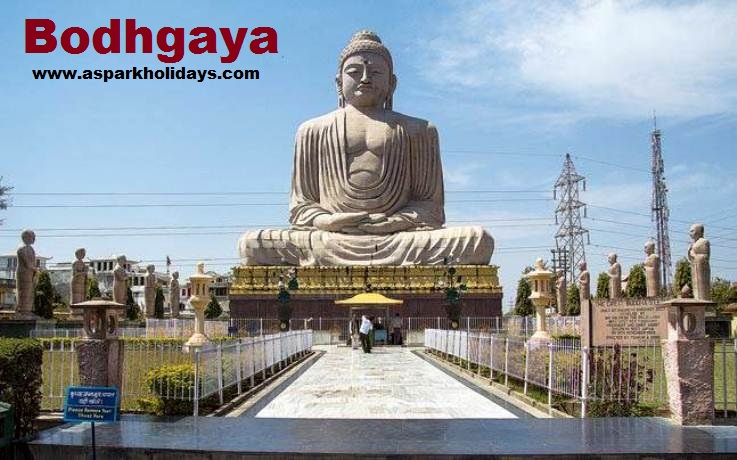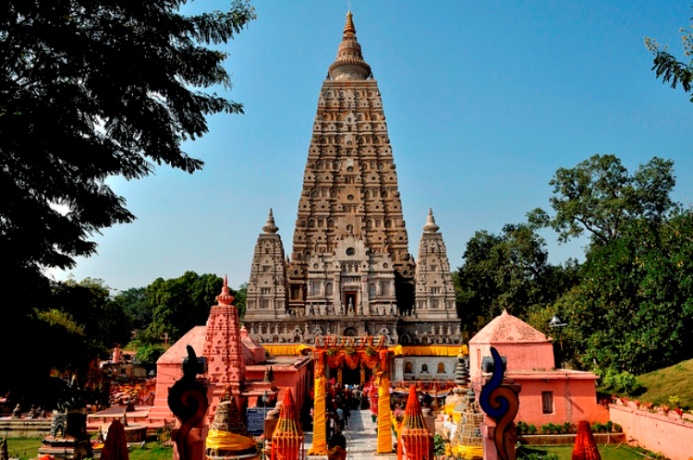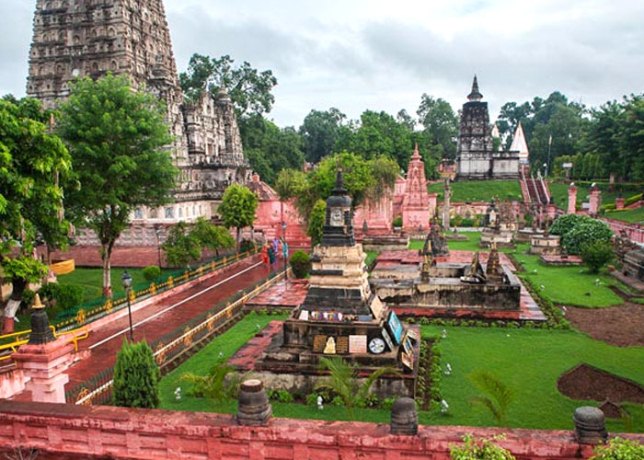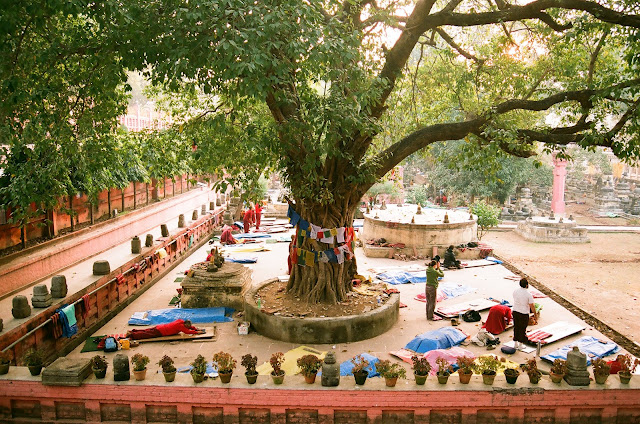
Tourist Attractions in Bodh Gaya- The main tourist attractions in Bodh Gaya are the Bodhi tree and Mahabodhi Temple. The other places of tourist interest in Bodh Gaya are Tibetan Monastery, Shaivite Monastery and Bodhgaya Archaeological Museum.
Bodhi Tree- The Bodhi tree is the peepal tree under which the Prince Gautama, also known as Siddhartha meditated and gained enlightenment in 533 BC. The Prince Gautama later came to known as Buddha. The Bodhi tree is still grown here through replantation of its saplings. The Emperor Ashoka also sent saplings of the tree to Sri Lanka through his son, Prince Mahinda. When the original Bodhi tree died in the 6th century, a sapling of the tree from Sri lanka was brought back and planted at the very spot where the original tree stood. The tree again fell down during the last part of the 19th century while some repair work was under way. Two of its saplings were again planted, one on the place of the old tree and the other a little away from it. Thus, the present Bodhi Tree is about a century old and believed to have been grown from a sapling from the original tree. The red sandstone slab, the Vajrasila, under the tree marks the place where Gautama sat in meditation. Today, various pilgrims tie pieces of coloured cloth on its branches when they come to pray.
Mahabodhi Temple- The Ashoka erected a shrine near the Bodhi tree which was replaced by the Mahabodhi temple in the 2nd century. This temple is unique in Buddhist architecture and an architectural amalgamation of many cultures. The temple bears the stamp of the architecture of the Gupta Dynasty and subsequent ages. The Mahabodhi Temple stands on a high and broad plinth and has a soaring 54 m high pyramidal spire, square cross-section and 4 smaller spires. In the main shrine, the temple has a huge gilded image of the Buddha in the seating pose, signifying enlightenment, which has mythological significance in the Buddhist lores. The walls of the temple carries the image of Lord Buddha, carved in different aspects. The temple carries inscriptions recording the visits of pilgrims from Sri Lanka, China and Mayanmar in the 7th the 10th centuries A.D. Hieun Tsang, the Chinese traveler, also visited the temple in the 7th Century. The entrance to the temple is through an ornamental gateway on the eastern side. The lotus tank where the Buddha might have bathed is situated to the south of the temple.
Chankramana or the Jewel Walk is situated to the north of temple. It is a raised platform which dates back to the 1st century and lotus flowers are carved on it. This platform marks the place where the Buddhawalked up and down while meditating on that whether he should reveal his knowledge to the world or not. The Animesh-Lochan Chaitya, is also situated near the Mahabodhi Temple and marks the spot where the Buddha stood gazing in gratitude after attaining enlightenment. This temple attracts Buddhists and Hindus from all over the world. The Tibetan, Japanese, Burmese, Bhutanese and Chinese temples are also situated which were built in recent years.
Tibetan Monastery- The Tibetan monastery was built in 1938 and has a large Dharma Chakra or the Wheel of Law inside it. This wheel must be turned three times when praying for forgiveness of sins. A large 2 m metal ceremonial drum in red and gold colour is also displayed.
Shaivite Monastery- Shaivite Monastery is situated near the Mahabodhi temple. The Shaivite Monastery has a cluster of four temples. These temples are surrounded by enchanting greenery and marked by architectural marvels. These temples have several samadhis (commemorative stones) in its vicinity. Just across are a number of cells, meant for residential purposes of monks. The Jagannath Temple is also situated near the Shaivite Monastery. This monastery is dedicated to Lord Shiva and has the statue of the deity, carved in glistening black stone.
Bodhgaya Archaeological Museum- The Bodhgaya Archaeological Museum is also a worth visiting place to know the religious art age of Buddha centered art forms. This museum contains a collection of antiques, sculptures and railings and posts from the original temple and gold, bronze and silver images of the Buddha and Hindu deities from 1st century B.C. to 11th century A.D. This museum is reflected through several art forms and is like a treasure house of artistic expression.
How to get There
By Air- The nearest airport is located in Patna, about 105 kms. from Bodh Gaya.
By Rail- The nearest railway station is located in Gaya, about 16 kms. from Bodh Gaya.
By Road- Bodh Gaya is directly connected by road to Gaya, Patna, Rajgir and Nalanda.
Need Aspark Help?
For Tour Packages, Vehicle Rental and Customer Care Support.
+91 9999 31 7846
booking@asparkholidays.comWhy Travel with Us?

Excellent Support
Our Team Available 24x7 for Customer support
Best Price & Savings
We Offer the Most Competitive Prices.



